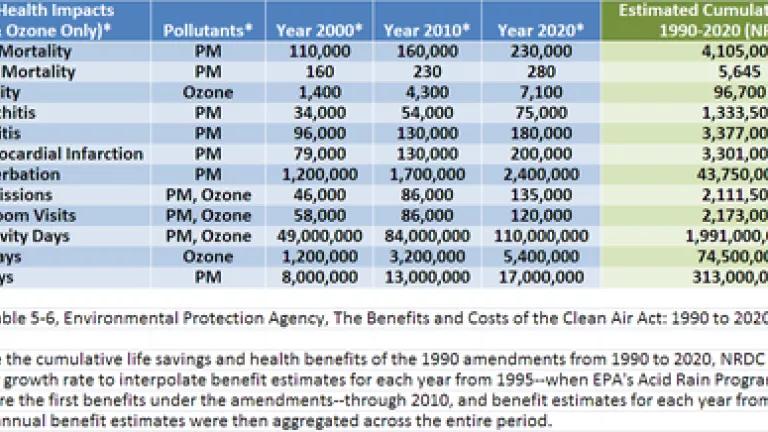
Today, the Environmental Protection Agency (EPA) released a new report on the economic and health benefits of the 1990 amendments to the Clean Air Act from 1990 to 2020. The results of the report are absolutely staggering—benefits of the 1990 amendments exceed costs by a factor of 30:1, with more than $2 trillion in economic benefits exceeding $65 billion in costs in 2020. But what’s even more eye-popping is when you total the cumulative benefits of the amendments over the entire period of 1990 to 2020.
NRDC’s own analysis of EPA’s report shows that the 1990 amendments will have cumulatively saved 4.2 million lives and avoided millions of cases of pollution-related illness by 2020—including 43.8 million cases of asthma exacerbation, 3.3 million heart attacks, 2.1 million hospital admissions and 2.2 million emergency room visits, and 313 million lost work days. For comparative purposes, 4.2 million is about the population of the city of Los Angeles. Here’s what we found:
For this analysis, we used data provided for target years 2000, 2010 and 2020 from EPA’s final report. For years 1990 to 2010, we assumed a roughly linear growth rate to calculate the benefit estimates for each year from 1995—when EPA’s Acid Rain Program Phase 1 began to secure the first significant benefits under the 1990 Clean Air Act amendments—through 2010. (Note: for these years, the growth rate was based on the difference between EPA’s year 2000 and 2010 estimates, divided by the number of years.) We made the same linear assumption for the benefit estimates for each year from 2010 to 2020. (Note: for these years, the growth rate was based on the difference between EPA’s year 2010 and 2020 estimates, divided by the number of years.) These annual benefit estimates were then aggregated across the entire period to provide the total cumulative avoided health impacts shown in the green column above.
Despite continued gloom-and-doom forecasts by big polluters and their corporate lobbyists to the contrary, EPA’s report and our analysis makes clear—without a shred of doubt—that the Clean Air Act has consistently provided HUGE public health, economic, and environmental benefits by reducing life-threatening pollution. And, as my colleague NRDC economist Laurie Johnson notes in her blog today, we can not only expect to see huge health and environmental benefits over this next decade, but also substantial economic growth, job creation, and innovation as a result of EPA’s good work.
In light of all this overwhelming new data, it would be irresponsible, if not downright dangerous, for politicians to interfere with a law delivering so many past, present, and future benefits to the American people.
